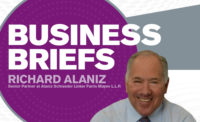EDITOR’S NOTE: This is the second part of a two-part series. In part one, published on Page 18 of the July 4 issue of The NEWS, Mark S. Dreux, a partner and head of the OSHA group at the Washington, District of Columbia law firm Arent Fox LLP, discussed how companies, especially those operating ammonia refrigeration facilities, are always on the radar of the Occupational Safety and Health Administration (OSHA). Here he offers advice on handling the actual inspection.
What should you do to get ready for Occupational Safety and Health Administration (OSHA) to inspect your facility? First of all, approach the inspection with the proper mindset, advised Mark S. Dreux, a partner and head of the OSHA group at the Washington, District of Columbia-based law firm Arent Fox LLP, speaking at a recent International Institute of Ammonia Refrigeration (IIAR) meeting.
“Think of the inspection as the beginning of the lawsuit process with OSHA,” Dreux said. “OSHA is not there to help you; it’s there to issue citations and fines. It’s what OSHA does.”
FORM A TEAM AND HAVE A PLAN
Two important steps in preparing for an inspection are to form an inspection team and develop a logistics plan, Dreux said.
The most important person on your inspection team will serve as a company spokesperson. You’ll need someone to answer OSHA’s questions. For this role, you’ll want someone who knows your processes, safety programs, and is a good communicator. Good communication can go a long way toward preventing citations.
You have a right to be physically present with OSHA wherever they go throughout the facility, so you’ll want to provide an escort for OSHA’s personnel. You want to make sure there’s someone there so they don’t get hurt. This person can also be the eyes and ears that records and evaluates what the OSHA rep is focusing on. Moreover, he or she may also be charged with taking photographs of any possible areas of concern to the OSHA rep.
“OSHA is going to ask for documents,” Dreux said. “You need a way to control the documents so they’ll receive only what they requested — no more and no less. This person also must have the authority to make things happen. When an OSHA rep says, ‘We’d like to interview these two employees from the third shift,’ you have to ensure you can get that done.”
These chosen individuals must have an understanding of OSHA standards, your company’s safety programs, and the reason(s) for OSHA’s visit.
“Say someone is injured in a confined space, and the OSHA rep asks the escort, ‘How does the confined space program work here?’ If that person doesn’t know, it’s going to reflect poorly on your facility,” Dreux said. “When it comes to developing a logistics plan, think about the routes you want the visiting OSHA rep to take as he or she tours the facility. How are you going to bring the inspector into your facility? Where are you going to set them up so they can conduct their employee interviews?
“Structure the walkthroughs so you know where the OSHA rep goes and what he or she sees,” Dreux said. “When the OSHA rep wants to do a walkthrough, you will get some advance notice. If you have a route planned, you can do a quick audit to make sure there are no obvious safety violations along the way.”
Your final preparation step is to make sure your records are in good order. Periodically review your company’s illness logs and workers’ compensation data and look for trends. Look at the citation data for your industry, which can be found on OSHA’s website. Review any job safety analyses your company has made. Ensure your records show you have been staying on top of any OSHA standards that have annual recurring training requirements.
“Keep good records that illustrate your company’s commitment to safety, because if you don’t, these things become easy gimmes for OSHA citations,” Dreux said.
WHEN OSHA IS ON-SITE
There are three parts to an OSHA inspection: the opening conference, the walkthrough, and the closing conference. Dreux advised that during the opening conference, you determine the scope of the inspection. Ask the OSHA rep why he or she’s there and what he or she is looking for. Be aware that if there’s a formal complaint (meaning one made in writing and signed by a current employee), you have a right to a copy of it.
Plan to meet daily with the on-site inspector. Ask, “Do you have any concerns? Did anything you’ve seen trouble you?” Address all concerns. Make sure they understand your processes. Also ask, “What do you want to do tomorrow or on your next visit?” so you can be prepared.
Ask the rep, “Do you need documents?” or “Do you need to interview people?” You are doing this partly to be helpful and also to prepare for and expedite the inspection.
“You want to get the inspector in and out of there as quickly as possible,” Dreux noted.
Prepare employees for their interviews with the OSHA rep by reviewing the relevant training, their role in any incident being investigated, and to tell the truth in answering any question from OSHA. After OSHA has interviewed an employee, debrief him or her. Ask if your company’s training and inspection preparation sessions covered all the right issues. This will help you adjust your prep for other employees.
“An employee might say, ‘You talked to me a lot about personal safety gear, but OSHA was focused on confined spaces,’” Dreux said. “Interview your employees to help you determine what OSHA inspectors are really looking at.”
Finally, be aware that words have power. According to Dreux, there are two “trick” questions OSHA reps often ask employees: “Is this a safe place to work?” and “What’s more important here, production or safety?”
“The answers OSHA gets to those two questions will give them a real clue about the attitude and culture of your company,” he said. “As you prepare for an inspection, think about how you can get positive answers to both.”
In addition, prepare your people for “technical speak.” What the OSHA rep calls something may not be what it’s called at your facility.
“One of the weaknesses with OSHA interviews is that the rep may speak in Washington alphabet soup,” Dreux said. “Your company may have ‘chemical safety sheets,’ while OSHA may ask about safety data sheets [SDS] or material safety data sheets [MSDS]. This may lead to employees not following the question, even though they may be very familiar with the topic.”
FINAL WORDS OF ADVICE
When you hear that your facility will be the target of an OSHA inspection, step back and examine the strengths and weaknesses of your safety program, and think about how you can focus the attention on the strengths. Although OSHA will come in looking for anything you’re doing wrong, you want to make sure they’re aware of all the things you’re doing right.
“It’s clear there’s a lot of risk on the horizon, but there are ways that risk can be minimized so you don’t have to call me to help you with your OSHA problems,” Dreux said. “I learned a long time ago that nobody enjoys talking to a lawyer.”
SIDEBAR: WIELD THE HAMMER WHEN NECESSARY
Don’t be afraid to implement swift and decisive discipline when a safety violation occurs, advised Mark S. Dreux, a partner and head of the OSHA group at the Washington, District of Columbia-based law firm Arent Fox LLP.
“I’m a big fan of having swift discipline because OSHA inspectors will sometimes ask employees, ‘If you violate a safety rule, does it count here?’ If the punishment was swift and memorable, the employee will respond, ‘Oh, yeah. I remember. I got sent home for three days,’ or, “There was a supervisor terminated because of that.’ If you make it memorable, they’ll remember it and tell OSHA. OSHA, in turn, will consider that an important factor in having a good safety program.”
SIDEBAR: THE VIEW FROM OSHA’S SIDE OF THE TABLE
Jordan Barab, deputy assistant secretary of Occupational Safety and Health Administration (OSHA), shared these thoughts and tips with The NEWS regarding preparing for an OSHA inspection.
“Under OSHA law, employers are responsible for providing a workplace free of known safety and health hazards. OSHA’s fact sheet on inspections explains the stages of the inspection process along with information on the appeals process.
“An OSHA inspection can be triggered by any of the following: imminent-danger situations; fatalities, hospitalizations, amputations, or loss of an eye; formal complaints from workers; referrals; targeted inspections of high-hazard industries; and follow-up inspections. OSHA will also inspect a work site if a compliance officer sees a hazard that could result in worker injury or death.
“The best way to prepare for an inspection is to be in compliance with OSHA regulations every day. To help achieve this, small- and medium-size employers can request a free and confidential consultation through OSHA’s On-Site Consultation Program. Consultants are not OSHA inspectors and do not issue citations; they work with employers to identify workplace hazards, provide advice, and assist in establishing safety and health management programs.
“Employers can also contact their nearest OSHA office to speak with a compliance assistance specialist [CAS] about OSHA standards and compliance assistance resources.”
Mark S. Dreux is head of the OSHA group in Washington D.C. law firm of Arent Fox. Contact him at 202-857-6405 or mark.dreux@arentfox.com. More information is available at www.managing-osha.com.
Publication date: 8/8/2016
Want more HVAC industry news and information? Join The NEWS on Facebook, Twitter, and LinkedIn today!









